Charles E W Bean, Diaries, AWM38 3DRL 606/264/1 - 1914 - 1938 - Part 13
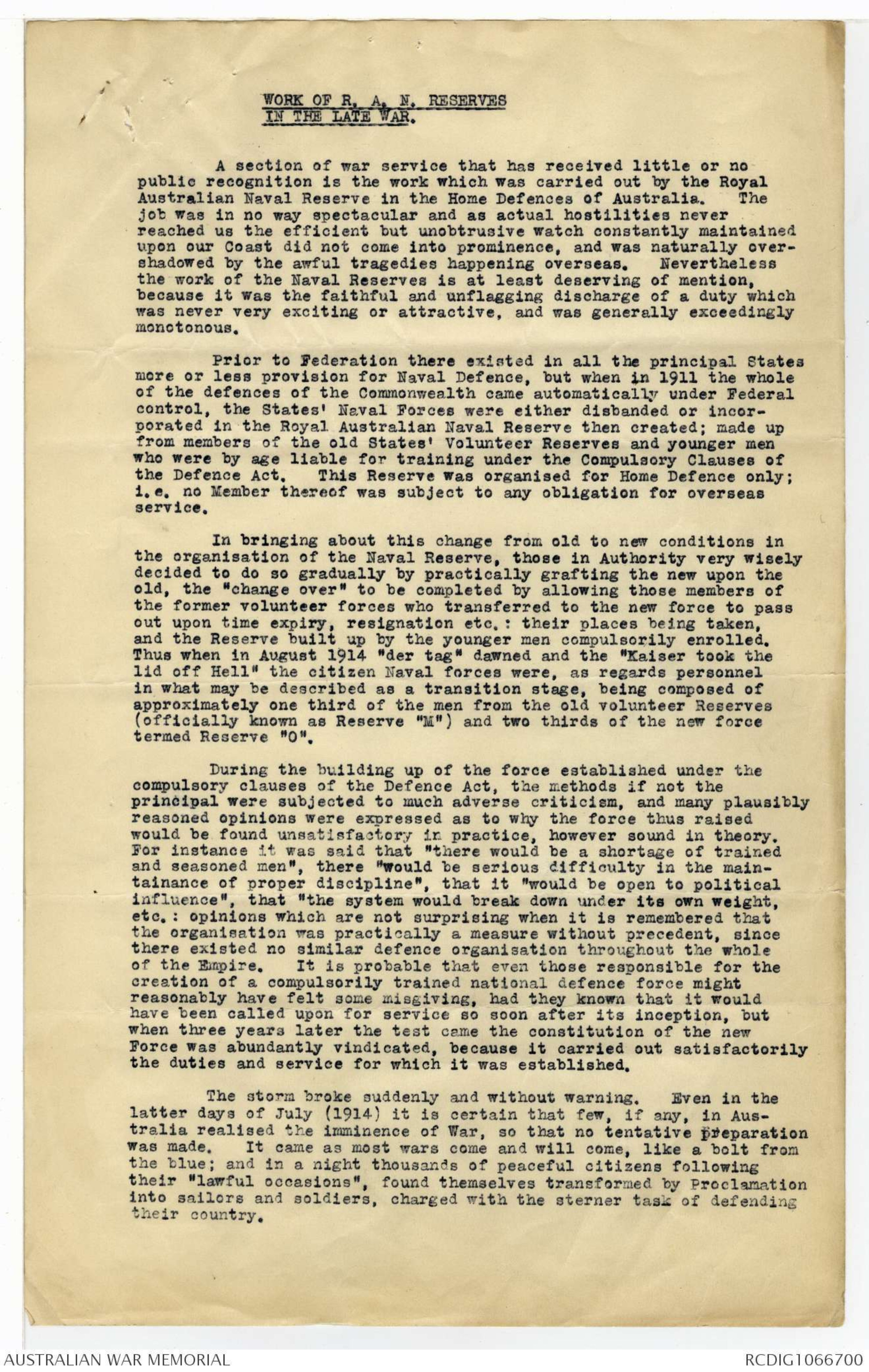
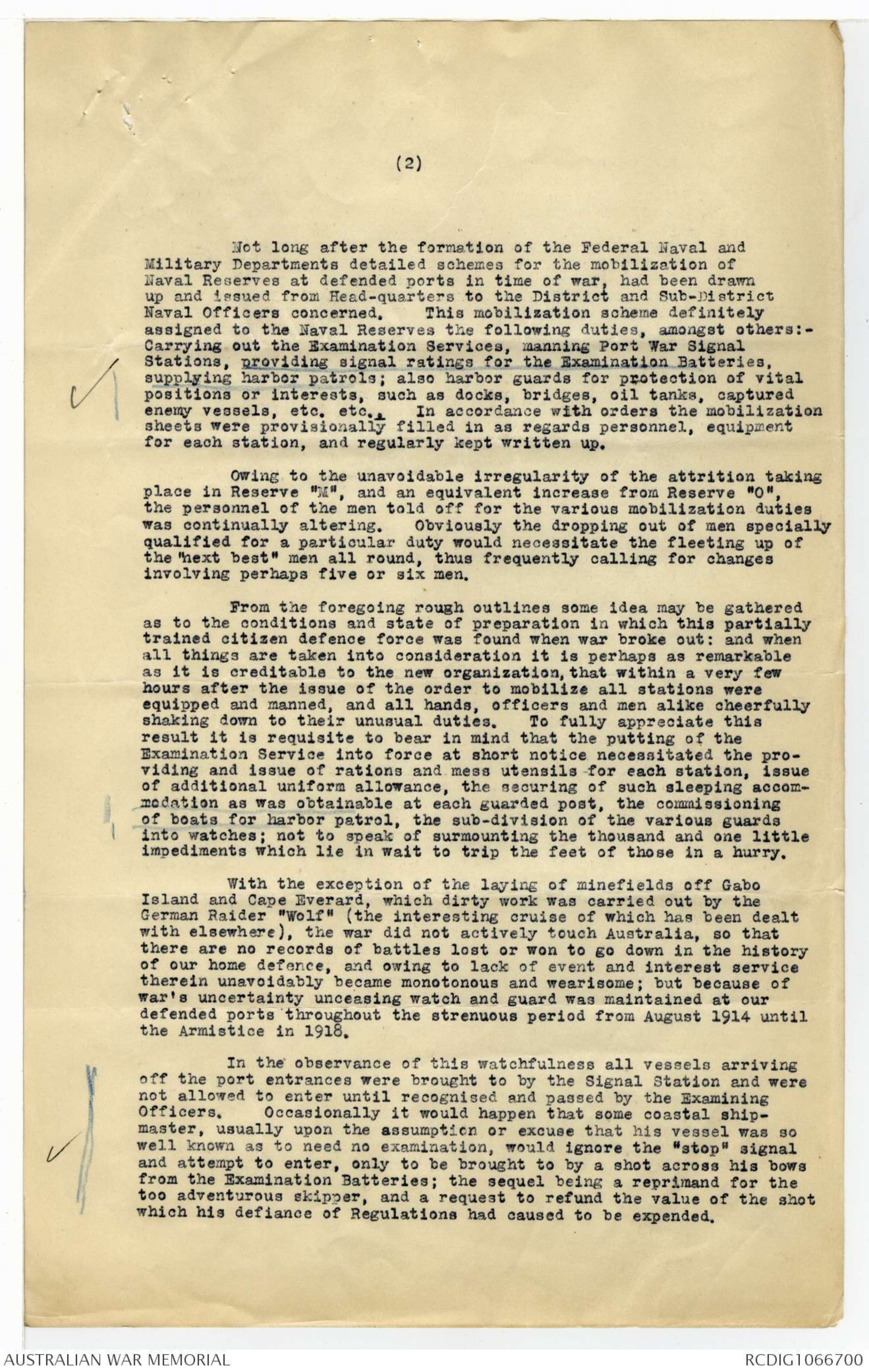

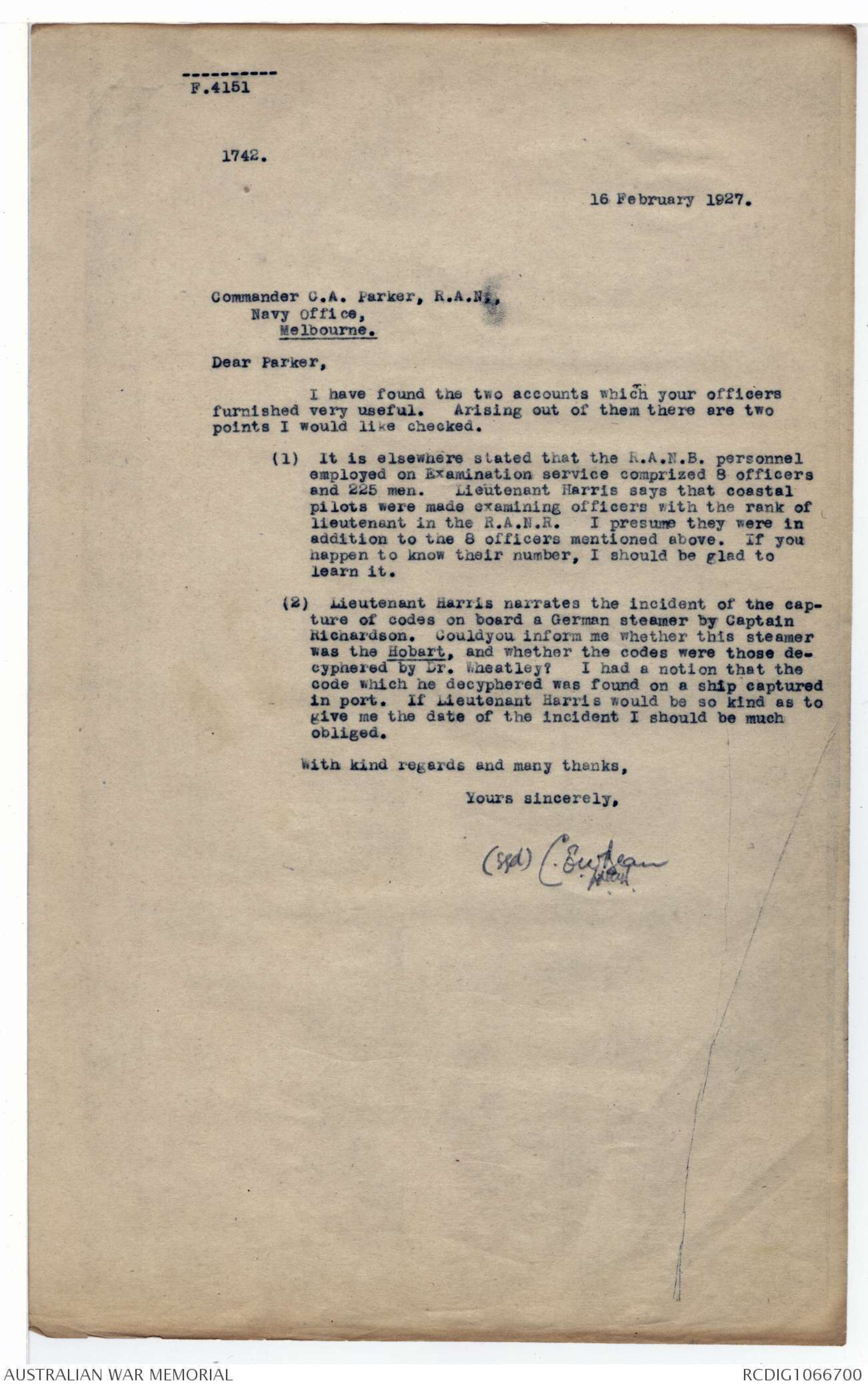
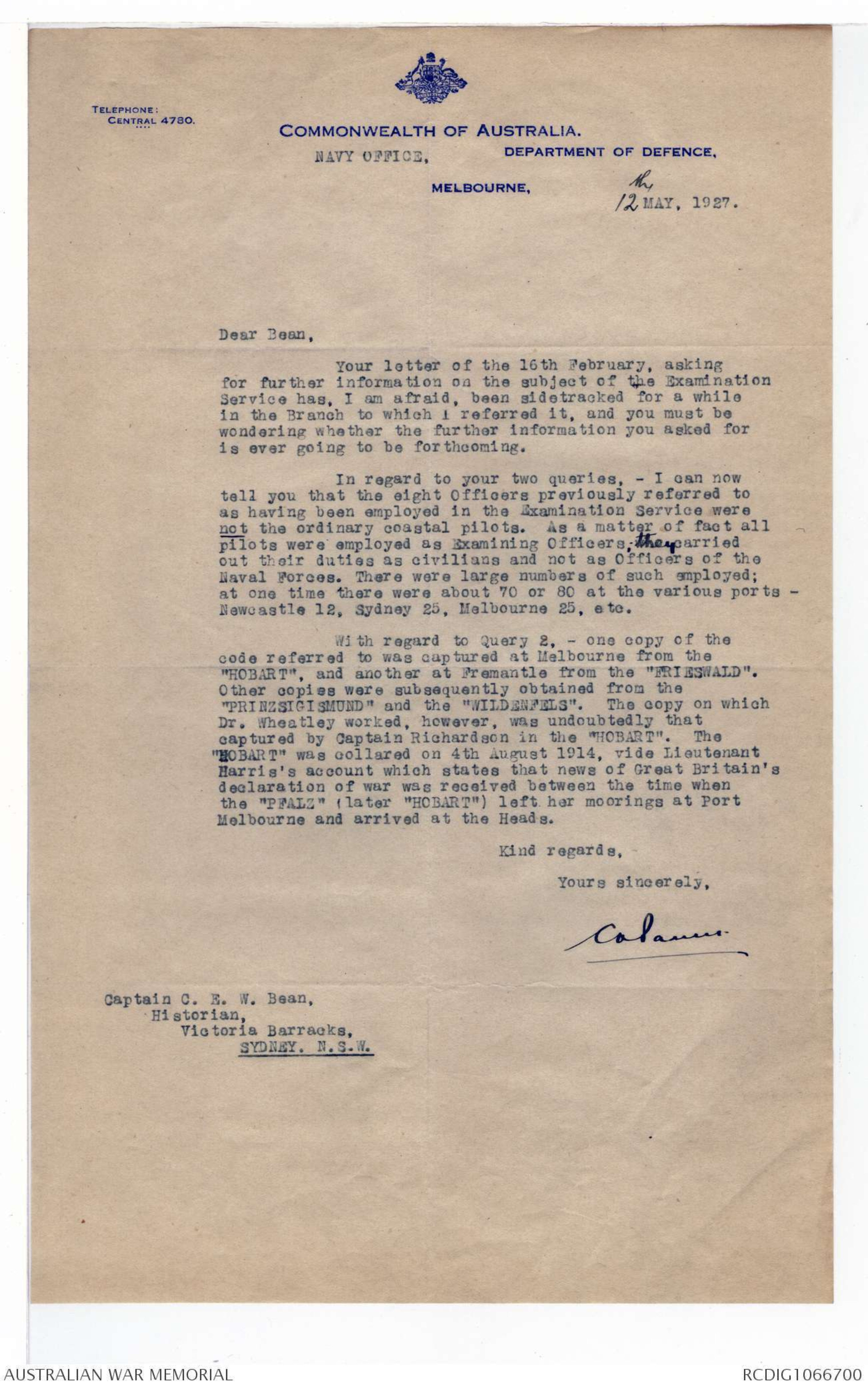
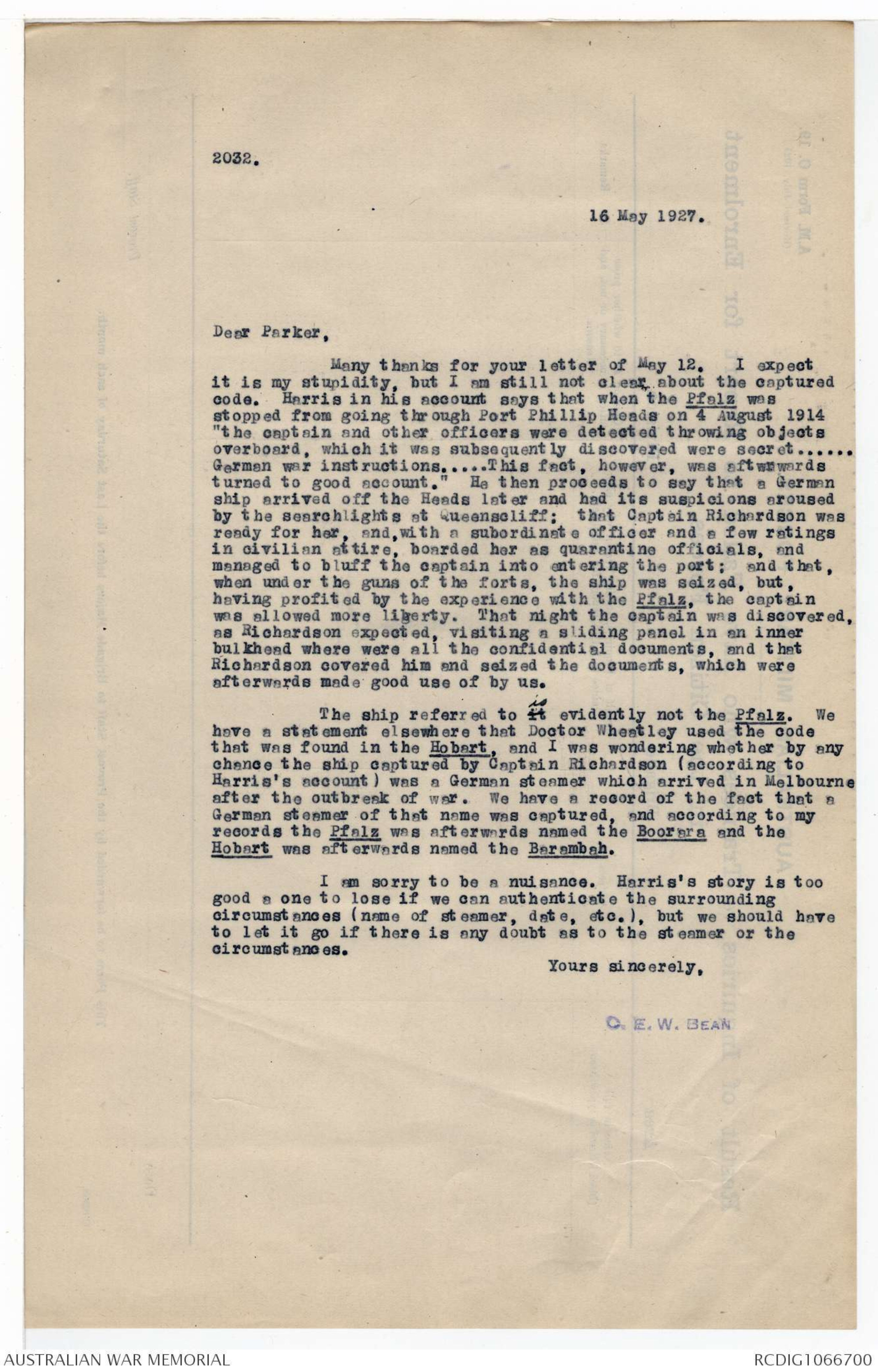
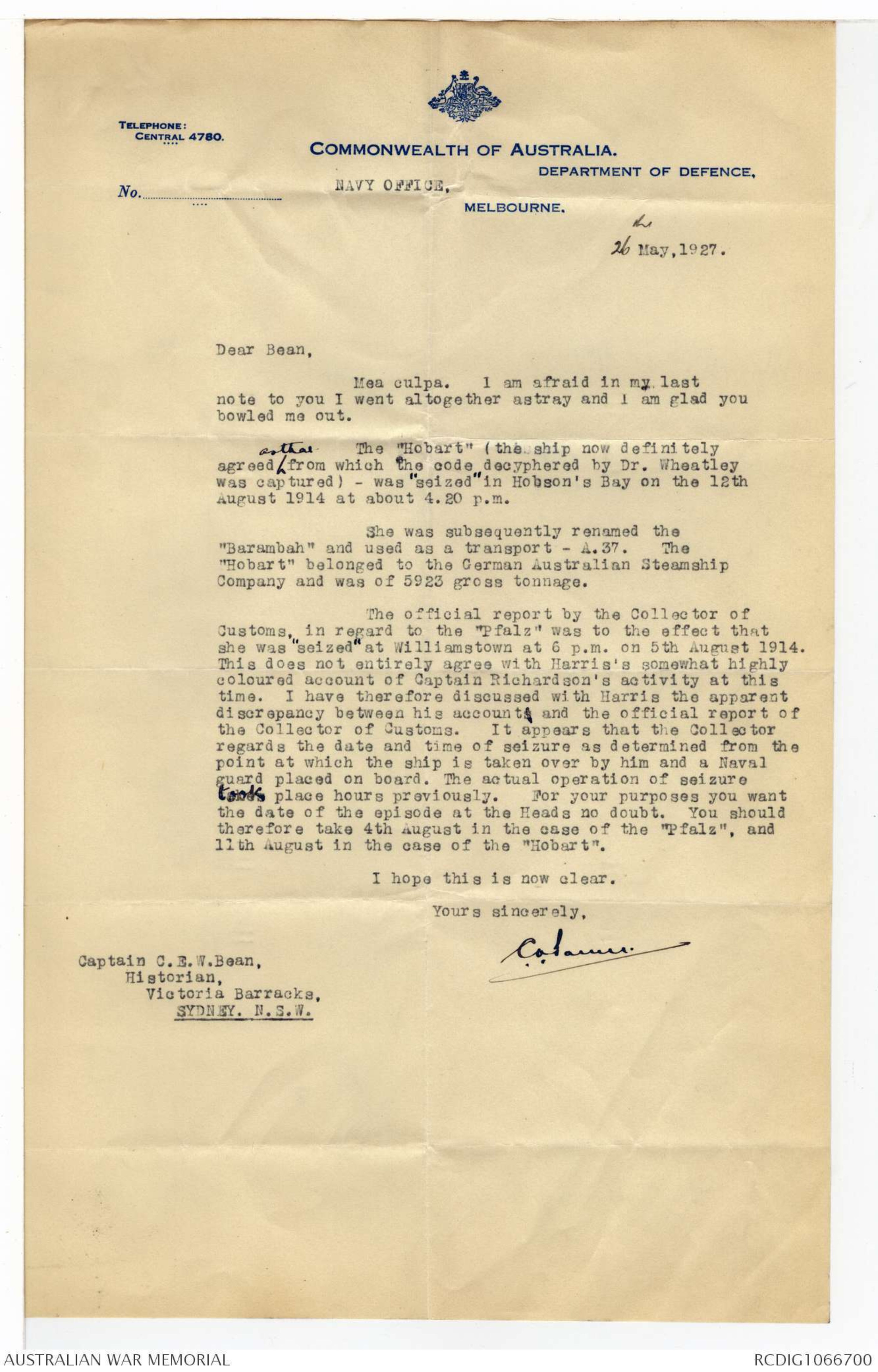
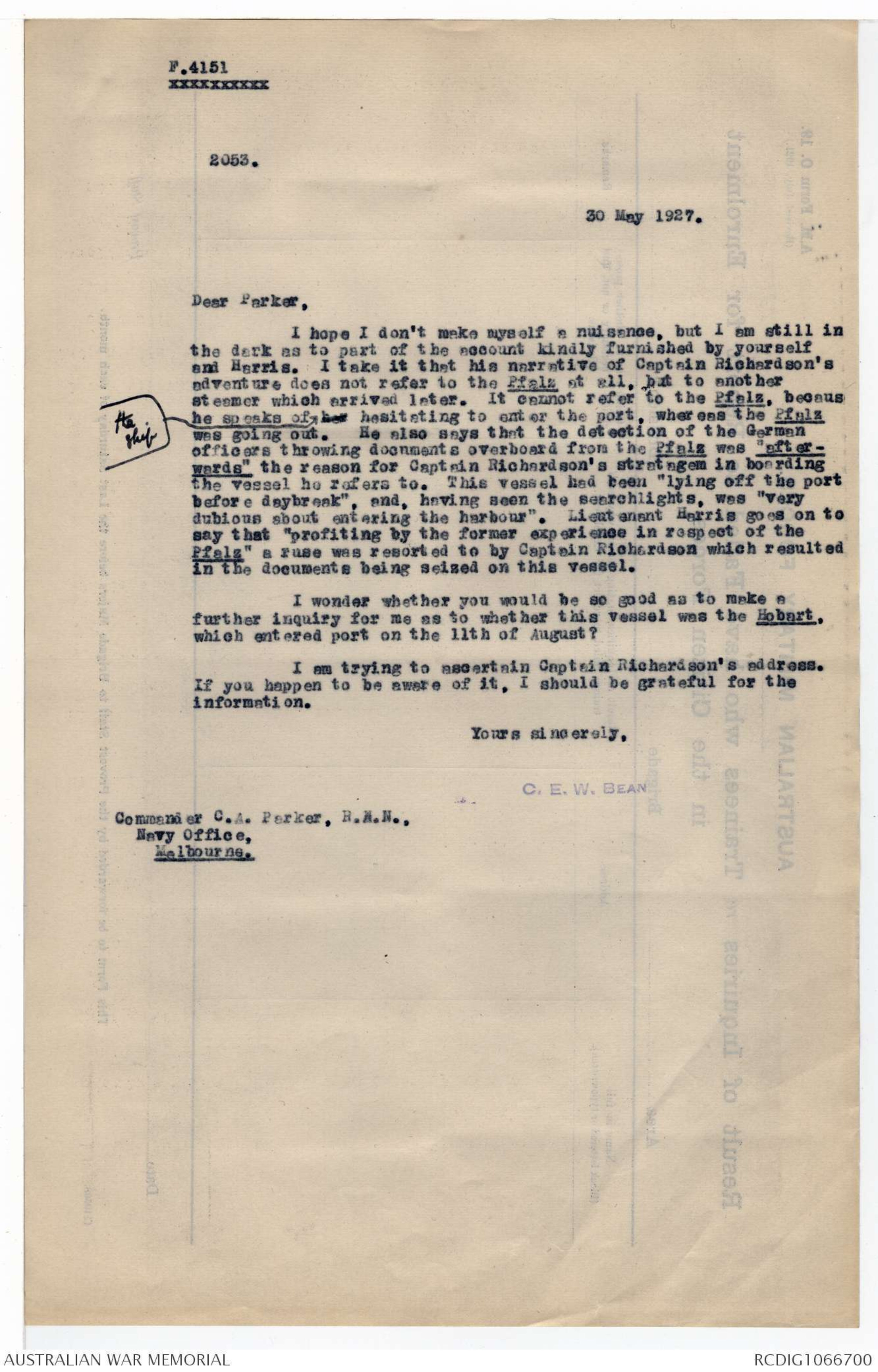
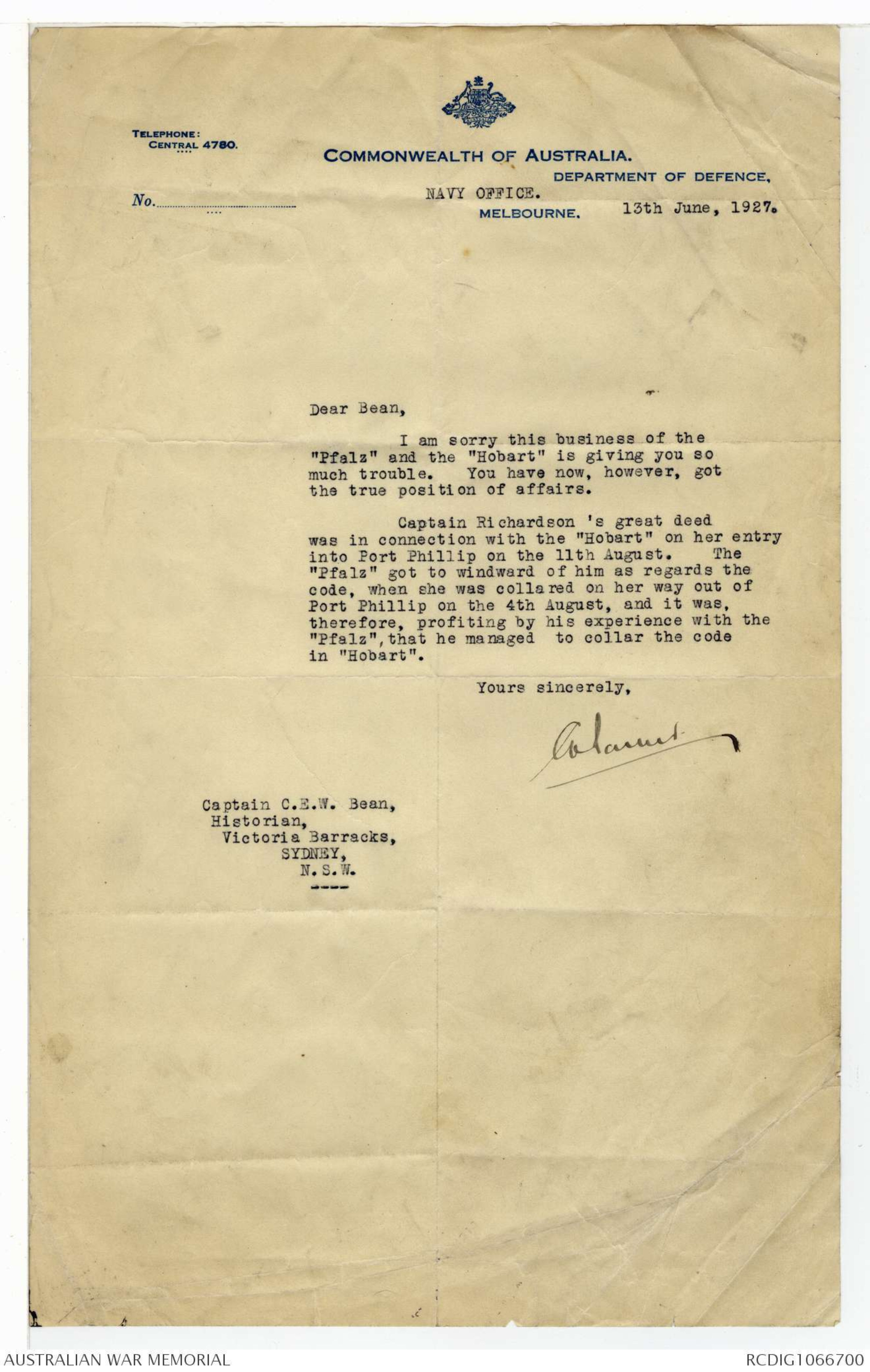
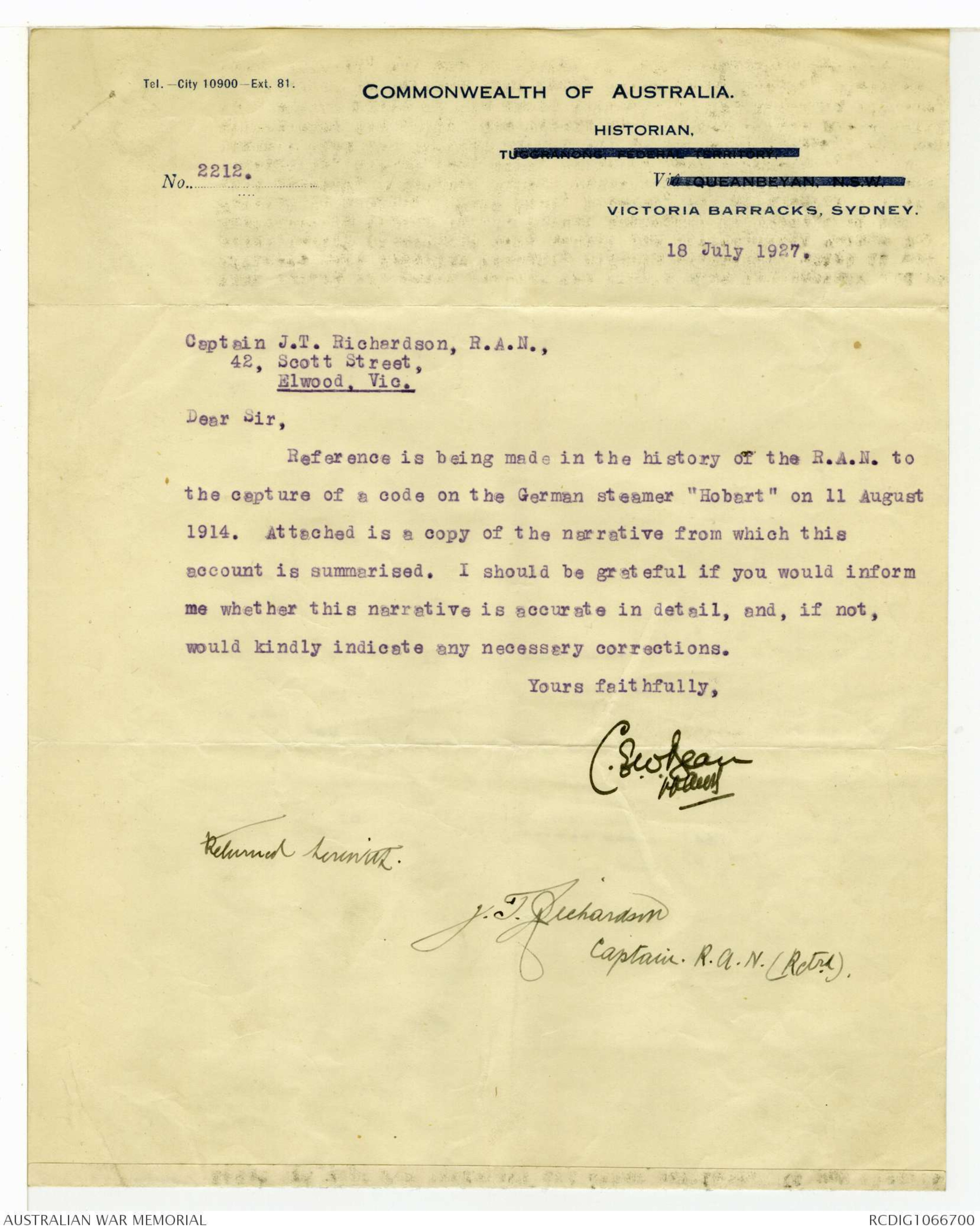
WORK OF R. A. N. RESERVES
IN THE LATE WAR.
A section of war service that has received little or no
public recognition is the work which was carried out by the Royal
Australian Naval Reserve in the Home Defences of Australia. The
job was in no way spectacular and as actual hostilities never
reached us the efficient but unobtrusive watch constantly maintained
upon our Coast did not come into prominence, and was naturally overshadowed
by the awful tragedies happening overseas. Nevertheless
the work of of the Naval Reserves is at least deserving of mention,
because it was the faithful and unflagging discharge of a duty which
was never very exciting or attractive, and was generally exceedingly
monotonous.
Prior to Federation there existed in all the principal States
more or less provision for Naval Defence, but when in 1911 the whole
of the defences of the Commonwealth came automatically under Federal
control, the States' Naval Forces were either disbanded or incorporated
in the Royal Australian Naval Reserve then created; made up
from members of the old States' Volunteer Reserves and younger men
who were by age liable for training under the Compulsory Clauses of
the Defence Act. This Reserve was organised for Home Defence only;
i.e. no Member thereof was subject to any obligation for overseas
service.
In bringing about this change from old to new conditions in
the organisation of the Naval Reserve, those in Authority very wisely
decided to do so gradually by practically grafting the new upon the
old, the "change over" to be completed by allowing those members of
the former volunteer forces who transferred to the new force to pass
out upon time expiry, resignation etc. : their places being taken,
and the Reserve built up by the younger men compulsorily enrolled.
Thus when in August 1914 "der tag" dawned and the "Kaiser took the
lid off Hell" the citizen Naval forces were, as regards personnel
in what may be described as a transition stage, being composed of
approximately one third of the men from the old volunteer Reserves
(officially known as Reserve "M") and two thirds of the new force
termed Reserve "O".
During the building up of the force established under the
compulsory clauses of the Defence Act, the methods if not the
principal were subjected to much adverse criticism, and many plausibly
reasoned opinions were expressed as to why the force thus raised
would be found unsatisfactory in practice, however sound in theory.
For instance it was said that "there would be a shortage of trained
and seasoned men", there "would be serious difficulty in the maintainance
of proper discipline", that it "would be open to political
influence", that "the system would break down under its own weight,
etc.: opinions which are not surprising when when it is remembered that
the organisation was practically a measure without precedent, since
there existed no similar defence organisation throughout the whole
of the Empire. It is probable that even those responsible for the
creation of a compulsorily trained national defence force might
reasonably have felt some misgiving, had they known that it would
have been called upon for service so soon after its inception, but
when three years later the test came the constitution of the new
Force was abundantly vindicated, because it carried out satisfactorily
the duties and service for which it was established.
The storm broke suddenly and without warning. Even in the
latter days of July (1914) it is certain that few, if any, in Australia
realised the imminence of War, so that no tentative preparation
was made. It came as most wars come and will come, like a bolt from
the blue; and in a night thousands of peaceful citizens following
their "lawful occasions", found themselves transformed by Proclamation
into sailors and soldiers, charged with the sterner task of defending
their country.
(2)
Not long after the formation of the Federal Naval and
Military Departments detailed schemes for the mobilization of
Naval Reserves at defended ports in time of war, had been drawn
up and issued from Head-quarters to the District and Sub-District
Naval Officers concerned. This mobilization scheme definitely
assigned to the Naval Reserves the following duties, amongst others:-
Carrying out the Examination Services, manning Port War Signal
Stations, providing signal ratings for the Examination Batteries,
supplying harbor patrols; also harbor guards for protection of vital
positions or interests, such as docks, bridges, oil tanks, captured
enemy vessels, etc. etc.. In accordance with orders the mobilization
sheets were provisionally filled in as regards personnel, equipment
for each station, and regularly kept written up.
Owing to the unavoidable irregularity of the attrition taking
place in Reserve "M", and an equivalent increase from Reserve "O",
the personnel of the men told off for the various mobilization duties
was continually altering. Obviously the dropping out of men specially
qualified for a particular duty would necessitate the fleeting up of
the "next best" men all round, thus frequently calling for changes
involving perhaps five or six men.
From the foregoing rough outlines some idea may be gathered
as to the conditions and state of preparation in which this partially
trained citizen defence force was found when war broke out: and when
all things are taken into consideration it is perhaps as remarkable
as it is creditable to the new organisation, that within a very few
hours after the issue of the order to mobilize all stations were
equipped and manned, and all hands, officers and men alike cheerfully
shaking down to their unusual duties. To fully appreciate this
result it is requisite to bear in mind that the putting of the
Examination Service into force at short notice necessitated the providing
and issue of rations and mess utensils for each station, issue
of additional uniform allowance, the securing of such sleeping accommodation
as was obtainable at each guarded post, the commissioning
of boats for harbor patrol, the sub-division of the various guards
into watches; not to speak of surmounting the thousand and one little
impediments which lie in wait to trip the feet of those in a hurry.
With the exception of the laying of minefields off Gabo
Island and Cape Everard, which dirty work was carried out by the
German Raider "Wolf" (the interesting cruise of which has been dealt
with elsewhere), the war did not actively touch Australia, so that
there are no records of battles lost or won to go down in the history
of our home defence, and owing to lack of event and interest service
therein unavoidably became monotonous and wearisome; but because of
war's uncertainty unceasing watch and guard was maintained at our
defended ports throughout the strenuous period from August 1914 until
the Armistice in 1918.
In the observance of this watchfulness all vessels arriving
off the port entrances were brought to by the Signal Station and were
not allowed to enter until recognised and passed by the Examining
Officers. Occasionally it would happen that some coastal shipmaster,
usually upon the assumption or excuse that his vessel was so
well known as to need no examination, would ignore the "stop" signal
and attempt to enter, only to be brought to by a shot across his bows
from the Examination Batteries; the sequel being a reprimand for the
too adventurous skipper, and a request to refund the value of the shot
which his defiance of Regulations had caused to be expended.
(3)
Perhaps the section of Home Defence which was least
opened to the stigma of monotony was service aboard the Examination
Steamers, where conditions did not lack excitement, particularly
during bad weather. In obedience to orders from Head-quarters
delaying or in any way unnecessarily interfering with mercantile
shipping had to be avoided, and ports were therefore kept open day
and night unless circumstances necessitated their being closed; so
that however dirty the night or rough the sea vessels making port
could generally rely upon being passed in without much delay.
For those serving aboard the Examination Steamer, on a black night,
with a howling gale, and with the little vessel rolling "gunnels
under" in a vicious cross sea, life was not altogether joyful; and
many a shivering Examining Officer must have fervently damned the
Kaiser and all his works. It is however to be said for the fibre
of young Australia that despite discomforts, and at times the danger
incidental to the job, service aboard the steamer was always popular
amongst the young Signalmen of the R.A.N.R., the majority of whom had
never been afloat before.
No history of the work of the Naval Reserves would be complete
without reference to the splendid services rendered by the
coastal Pilots, belonging to the Navigation Department; who, with
the rank of Lieutenant, R.A.N.R., were mobilised for service as
Examining Officers immediately war broke out, and during its continuation
carried out their duties with the greatest keenness and
efficiency.
NEWCASTLE, N.S.W.
8/12/'26.
F.4151
1742.
16 February 1927.
Commander C.A. Parker, R.A.N.,
Navy Office,
Melbourne.
Dear Parker,
I have found the two accounts which your officers
furnished very useful. Arising out of them there are two
points I would like checked.
(1) It is elsewhere stated that the R.A.N.B. personnel
employed on Examination service comprized 8 officers
and 225 men. Lieutenant Harris says that coastal
pilots were made examining officers with the rank of
lieutenant in the R.A.N.R. I presume they were in
addition to the 8 officers mentioned above. If you
happen to know their number, I should be glad to
learn it.
(2) Lieutenant Harris narrates the incident of the capture
of codes on board a German steamer by Captain
Richardson. Couldyou inform me whether this steamer
was the Hobart, and whether the codes were those decyphered
by Dr. Wheatley? I had a notion that the
code which he decyphered was found on a ship captured
in port. If Lieutenant Harris would be so kind as to
give me the date of the incident I should be much
obliged.
With kind regards and many thanks,
Yours sincerely,
(sgd) C.E.W. Bean
TELEPHONE:
CENTRAL 4780.
COMMONWEALTH OF AUSTRALIA.
NAVY OFFICE, DEPARTMENT OF DEFENCE,
MELBOURNE,
12th MAY, 1927
Dear Bean,
Your letter of the 16th February, asking
for further information of the subject of the Examination
Service has, I am afraid, been sidetracked for a while
in the Branch to which I referred it, and you must be
wondering whether the further information you asked for
is ever going to be forthcoming.
In regard to your two queries, - I can now
tell you that the eight Officers previously referred to
as having been employed in the Examination Service were
not the ordinary coastal pilots. As a matter of fact all
pilots were employed as Examining Officers, they carried
out their duties as civilians and not as Officers of the
Naval Forces. There were large numbers of such employed;
at one time there were about 70 or 80 at the various ports -
Newcastle 12, Sydney 25, Melbourne 25, etc.
With regard to Query 2, - one copy of the
code referred to was captured at Melbourne from the
"HOBART", and another at Fremantle from the "FRIESWALD".
Other copies were subsequently obtained from the
"PRINZSIGISMUND" and the "WILDENFELS". The copy on which
Dr. Wheatley worked, however, was undoubtedly that
captured by Captain Richardson in the "HOBART". The
"HOBART" was collared on 4th August 1914, vide Lieutenant
Harris's account which states that news of Great Britain's
declaration of war was received between the time when
the "PFALZ" ( later "HOBART") left her moorings at Port
Melbourne and arrived at the Heads.
Kind regards,
Yours sincerely,
C.A.Parker.
Captain C. E. W. Bean,
Historian,
Victoria Barracks,
SYDNEY. N.S.W.
2032.
16 May 1927.
Dear Parker,
Many thanks for your letter of May 12. I expect
it is my stupidity, but I am still not clear about the captured
code. Harris in his account says that when the Pfalz was
stopped from going through Port Phillip Heads on 4 August 1914
"the captain and other officers were detected throwing objects
overboard, which it was subsequently discovered were secret....
German war instructions....This fact, however, was afterwards
turned to good account." He then proceeds to say that a German
ship arrived off the Heads later and had its suspicions aroused
by the searchlights at Queenscliff; that Captain Richardson was
ready for her, and,with a subordinate officer and a few ratings
in civilian attire, boarded her as quarantine officials, and
managed to bluff the captain into entering the port; and that,
when under the guns of the forts, the ship was seized, but,
having profited by the experience with the Pfalz, the captain
was allowed more liberty. That night the captain was discovered,
as Richardson expected, visiting a sliding panel in an inner
bulkhead where were all the confidential documents, and that
Richardson covered him and seized the documents, which were
afterwards made good use of by us.
The ship referred to it is evidently not the Pfalz. We
have a statement elsewhere that Doctor Wheatley used the code
that was found in the Hobart, and I was wondering whether by any
chance the ship captured by Captain Richardson (according to
Harris's account) was a German steamer which arrived in Melbourne
after the outbreak of war. We have a record of the fact that a
German steamer of that name was captured, according to my
records the Pfalz was afterwards named the Boorara and the
Hobart was afterwards named the Barambah.
I am sorry to be a nuisance. Harris's story is too
good a one to lose if we can authenticate the surrounding
circumstances (name of steamer, date, etc.), but we should have
to let it go if there is any doubt as to the steamer or the
circumstances.
Yours sincerely,
C. E. W. BEAN
TELEPHONE:
CENTRAL 4780.
No.
COMMONWEALTH OF AUSTRALIA.
DEPARTMENT OF DEFENCE,
NAVY OFFICE,
MELBOURNE.
26th May, 1927.
Dear Bean,
Mea culpa. I am afraid in my last
not to you I went altogether astray and I am glad you
bowled me out.
The "Hobart" (the ship now definitely
agreed ^as that from which the code decyphered by Dr. Wheatley
was captured) - was "seized" in Hobson's Bay on the 12th
August 1914 at about 4.20 p.m.
She was subsequently renamed the
"Barambah" and used as a transport - A.37. The
"Hobart" belonged to the German Australian Steamship
Company and was of 5923 gross tonnage.
The official report by the Collector of
Customs, in regard to the "Pfalz" was to the effect that
she was "seized" at Williamstown at 6 p.m. on 5th August 1914.
This does not entirely agree with Harris's somewhat highly
coloured account of Captain Richardson's activity at this
time. I have therefore discussed with Harris the apparent
discrepancy between his accounts and the official report of
the Collector of Customs. It appears that the Collector
regards the date and time of seizure as determined from the
point at which the ship is taken over by him and a Naval
guard placed on board. The actual operation of seizuretakes took place hours previously. For your purposes you want
the date of the episode at the Heads no doubt. You should
therefore take 4th August in the case of the "Pfalz", and
11th August in the case of the "Hobart".
I hope this is now clear.
Yours sincerely,
C.A.Parker
Captain C.E.W.Bean,
Historian,
Victoria Barracks,
SYDNEY. N.S.W.
F.4151
xxxxxxxxxx
2053.
30 May 1927.
Dear Parker,
I hope I don't make myself a nuisance, but I am still in
the dark as to part of the account kindly furnished by yourself
and Harris. I take it that his narrative of Captain Richardson's
adventure does not refer to the Pfalz at all, but to another
steamer which arrived later. It cannot refer to the Pfalz, because
he speaks of ^the ship hes hesitating to enter the port, whereas the Pfalz
was going out. He also says that the detection of the German
officers throwing documents overboard from the Pfalz was "afterwards"
the reason for Captain Richardson's stratagem in boarding
the vessel he refers to. This vessel has been "lying off the port
before daybreak", and, having seen the searchlights, was "very
dubious about entering the harbour". Lieutenant Harris goes on to
say that "profiting by the former experience in respect of the
Pfalz" a ruse was resorted to by Captain Richardson which resulted
in the documents being seized on this vessel.
I wonder whether you would be so good as to make a
further inquiry for me as to whether this vessel was the Hobart,
which entered port on the 11th of August?
I am trying to ascertain Captain Richardson's address.
If you happen to be aware of it, I should be grateful for the
information.
Yours sincerely,
C. E. W. BEAN
Commander C.A. Parker, R.A.N.,
Navy Office,
Melbourne.
TELEPHONE:
CENTRAL 4780.
No.
COMMONWEALTH OF AUSTRALIA.
DEPARTMENT OF DEFENCE,
NAVY OFFICE.
MELBOURNE. 13th June, 1927
Dear Bean,
I am sorry this business of the
"Pfalz" and the "Hobart" is giving you so
much trouble. You have now, however, got
the true position of affairs.
Captain Richardson 's great deed
was in connection with the "Hobart" on her entry
into Port Phillip on the 11th August. The
"Pfalz" got to windward of him as regards the
code, when she was collared on her way out of
Port Phillip on the 4th August, and it was,
therefore, profiting by his experience with the
"Pfalz", that he managed to collar the code
in "Hobart".
Yours sincerely
C.A.Parker.
Captain C.E.W. Bean,
Historian,
Victoria Barracks,
SYDNEY,
N.S.W.
Tel.—City 10900—Ext. 81.
COMMONWEALTH OF AUSTRALIA.
HISTORIANTUGERANONG, FEDERAL TERRITORY,QUEANBEYAN, N.S.W.
VICTORIA BARRACKS, SYDNEY.
No. 2212.
18 July 1927.
Captain J.T. Richardson, R.A.N.,
42, Scott Street,
Elwood, Vic.
Dear Sir,
Reference is being made in the history of the R.A.N. to
the capture of a code on the German steamer "Hobart" on 11 August
1914. Attached is a copy of the narrative from which this
account is summarised. I should be grateful if you would inform
me whether this narrative is accurate in detail, and, if not,
would kindly indicate any necessary corrections.
Yours faithfully,
C.E.W.Bean
Returned herewith.
J.T. Richardson
Captain. R.A.N. (Retrd).
 Ray Wilson
Ray WilsonThis transcription item is now locked to you for editing. To release the lock either Save your changes or Cancel.
This lock will be automatically released after 60 minutes of inactivity.